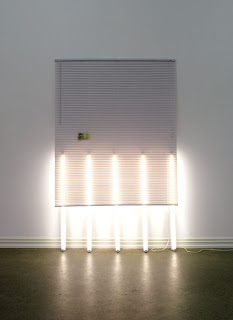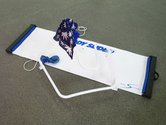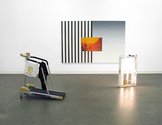John Hurrell – 20 March, 2009
In his examination of the omnipresent, pervasive drive of commerce to exploit a vast range of social, religious, tourist, aesthetic and bodily longings, Basher rarely fixes down juxtapositions for good. Items are placed thoughtfully in proximity to each other, perhaps taped one on the other - but never glued. It is as if it is part of the mercantile impulse to keep all options open. Never make permanent, in case that combination doesn't sell and you are stuck with it.
This new exhibition by Martin Basher is radically different from his previous show at Starkwhite of paintings, though there are one or two of those included. This display is more like a sprawling installation of assemblages and wall hangings. It seems at first glance to belong to the dada collage tradition established by Schwitters as perpetuated by Rauschenberg, Stockholder and others. Some vertical sculptures are like Rauschenberg, but others are more scattered, but tidyish, in plastic bags, stacks and bundles.
It also has a superficial look akin to Dan Arps and Simon Denny. However Basher uses a different sort of syntax, a more individualistic ‘sentence’ or rebus structure preoccupied with consumer desire, capitalist global strategies, and the construction, wooing and milking of purchasing selves - usually youthful. Denny on the other hand is more interested mixing up disparate technologies and minutiae from design history, and Arps in creating a sort of nihilistic art lab where meaning can be stumbled upon by jamming opposites together or using unconventional mark making methods that bring up new blends of mental connection.
Most of the material Basher uses comes from Two Dollar shops, Warehouses, head shops and clearance stores, packaging as well as purchasable items. It functions not as material laden with seductive visual potential, but as symbol substance that is deliberately not broken down or dissipated. It’s left intact so it can be read. They usually function in figurative terms as synecdoche (where one part is used to signify a whole) or as metonymy (where things become linked by association, through usage), and are positioned in carefully allocated, internally resonating, groups.
In his examination of the omnipresent, pervasive drive of commerce to exploit a vast range of social, religious, tourist, aesthetic and bodily longings, Basher rarely fixes down juxtapositions for good. Items are placed thoughtfully in proximity to each other, perhaps taped one on the other - but never glued. It is as if it is part of the mercantile impulse to keep all options open. Never make permanent, in case that combination doesn’t sell and you are stuck with it.
Basher’s groupings are arranged, but not too much so. As groups of signs, their compositions are decisively clear but not super elegant. They seem to want to stick to the banality of their sources, and so don’t draw you in with formal sophistication, re the placement of their shape, colour and line.(Being in the space is a different experience from what the above images would suggest.) Same with humour. There is nothing too obvious. Amusing semantic connections could almost be accidental, but you are not quite sure. The work doesn’t seem to want to be too clever.
This is an unexpected sculpture show from Basher, one that is startlingly bold. From the point of view of reading his collected batches of tropes, there is too much in the room, but maybe that is a tongue-in-cheek comment on the commercial world - outside the gallery - that inspired the show.
John Hurrell





 Two Rooms presents a program of residencies and projects
Two Rooms presents a program of residencies and projects Advertising in this column
Advertising in this column



This Discussion has 0 comments.
Comment
Participate
Register to Participate.
Sign in
Sign in to an existing account.